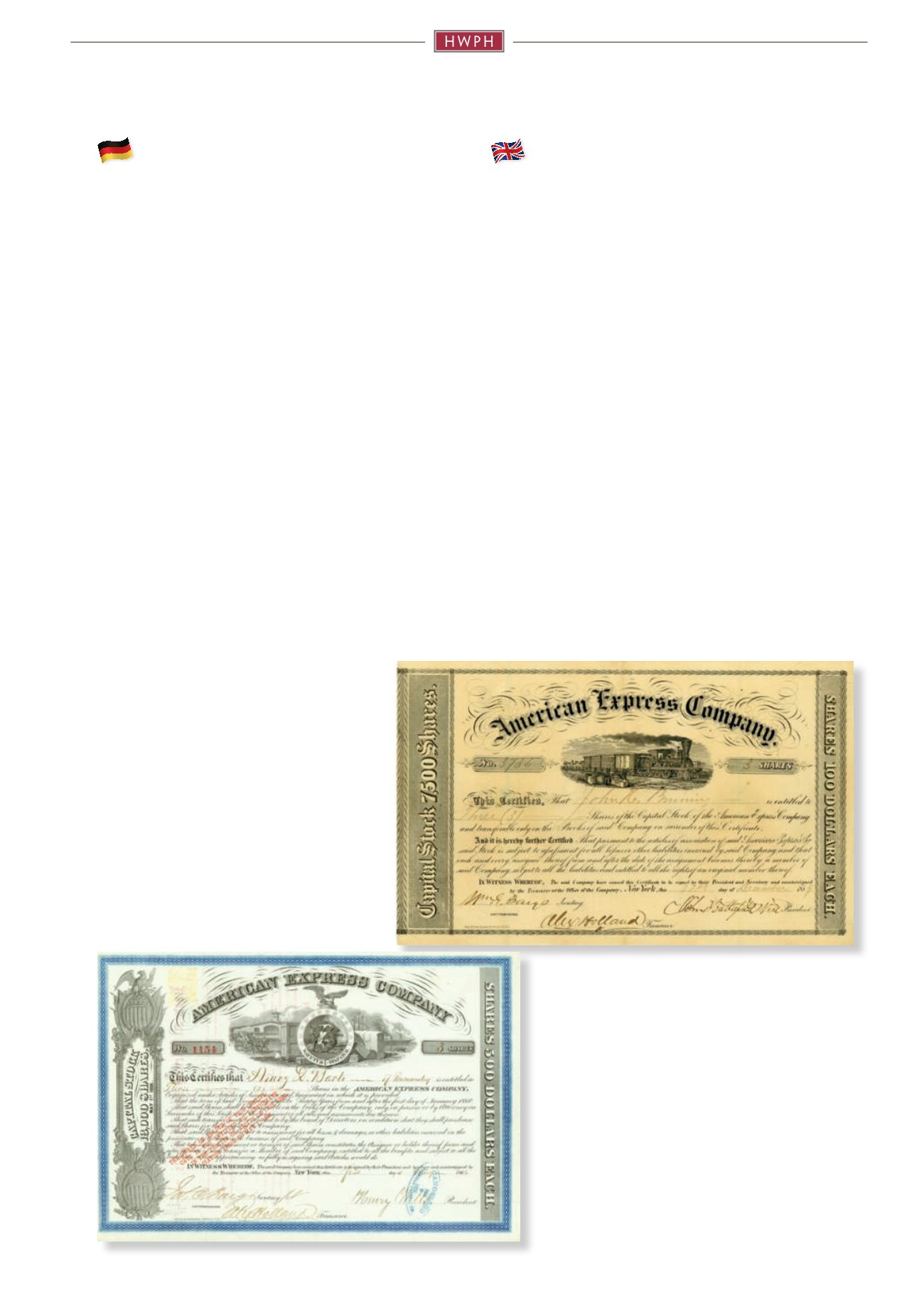

30
American Express CompanyIn 1841 Henry Wells undertook his first „express“ trip
by rail and stagecoach from Albany (New York) to Buf-
falo. In his luggage he included gold, silver, paper money, and
stocks and bonds for merchants in Buffalo. Nine years later, on
March 18, 1850, the American Express Company was founded.
Henry Wells, William G. Fargo, and others merged their stage-
coach businesses into it. To be sure, the company was limited
to a period of ten years so that on New Year’s Day 1859 it was
totally auctioned off. The purchaser was a new Amexco, whose
owners were identical with those of the old company. Thus the
certificates distributed starting January 1860 were given a new
layout. While the first documents had an image of a train, on
the newer documents a dog’s head was sketched. In 1868 the
company merged with the Merchant’s Union Express to form
the American Merchant’s Union Express. In 1873 the firm was
renamed the American Express Company. In its beginning
years, American Express offered no financial services, but the
company had many large banks and brokers as their custo-
mers. American Express realized that transporting share certi-
ficates, currencies and other bank products is much more pro-
fitable than transporting heavy freight. In 1882, money orders
got part of the services American Express offered. This was the
first step in the finance business. The first traveler cheques
were offered in 1891. American Express entered the card busi-
ness not before 1958. The first cards were made of paper. In
1959 the first plastic card was introduced. The first Credit
Card, called Optima Card, was offered by the American Express
Company in 1987. Round about one fourth of all Credit Card
transactions in the United States are done with an Amex-Card
nowadays.
American Express CompanyIm Jahr 1841 unternahm Henry Wells seine erste
„Express“-Fahrt abwechselnd mit Bahn und Pferdekut-
sche von Albany (New York) nach Buffalo. Im Gepäck hatte er
unter anderem Gold, Silber, Papiergeld sowie Wertpapiere für die
Kaufleute in Buffalo. Neun Jahre später, am 18. März 1850, wur-
de die American Express Company gegründet. In ihr schlossen
Henry Wells, William G. Fargo und andere ihr Postkutschenge-
schäft zusammen. Die Gesellschaft war allerdings auf eine Dauer
von zehn Jahren beschränkt, so dass sie Silvester 1859 auf einen
Schlag versteigert wurde. Käufer war eine neue Amexco, deren
Eigentümer mit denen der alten Gesellschaft identisch waren.
Daher wurden die ab Januar 1860 ausgegebenen Aktien neu ge-
staltet. Während die ersten Papiere eine Zugvignette enthielten,
war auf den neueren Papieren ein Hundekopf abgebildet. 1868
fusionierte die Gesellschaft mit der Merchants Union Express
zur American Merchants Union Express. 1873 kam es dann zur
Umbenennung der Firma in American Express Company. An-
fangs bot American Express keine Finanzdienstleistungen an. Da
aber viele große Banken zu den Kunden gehörten, erkannte die
Firma schnell, dass das Transportieren von Aktienzertifikaten,
Währungen und anderen Bankgütern rentabler war als der
Transport von größerer Fracht. Ab 1882 nahm American Express
Postanweisungen in seine Dienstleistungspalette auf. Dies war
der Einstieg ins Finanzbusiness. Die ersten Reiseschecks gab die
Firma 1891 aus. Erst im Oktober 1958 stieg die Gesellschaft ins
Kartengeschäft ein. Nachdem die ersten „Karten“ noch aus Pa-
pier waren, folgte 1959 die erste Plastikkarte. Die erste Kreditkar-
te, die Optima Card, bot American Express 1987 an. Heute wird
rund ein Viertel aller Kreditkartentransaktionen in den USA mit
einer Amex-Karte ausgeführt.
1859 emittierte American Express-Aktie mit der Ori-
ginal-Signatur von John Butterfield, William G. Fargo
und Alex Holland. Bei den Zertifikaten gibt es immer
kleine Abweichungen in den Vignetten. Dies diente
als Sicherheitsmerkmal.
The 1859 issued American Express certificate was
signed by John Butterfield, William G. Fargo and Alex
Holland. If you compare the certificates, you will find
small differences at the vignettes of the share certifi-
cates. This was to reduce the risk of falsification.
Die Vignette mit dem Hundekopf löste die Zugvignetten ab.
Er sollte Vertrauen symbolisieren. Mal blickt der Hund nach
rechts oder wie hier nach links.
The vignette witht he dog succeded the railway vignette.
The dog symbolises trust. There are varieties where the dog
looks to the right sight or to the left side like at the shown
certifciate.


















